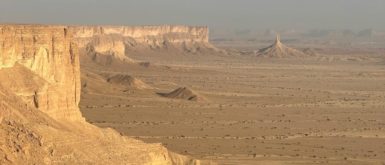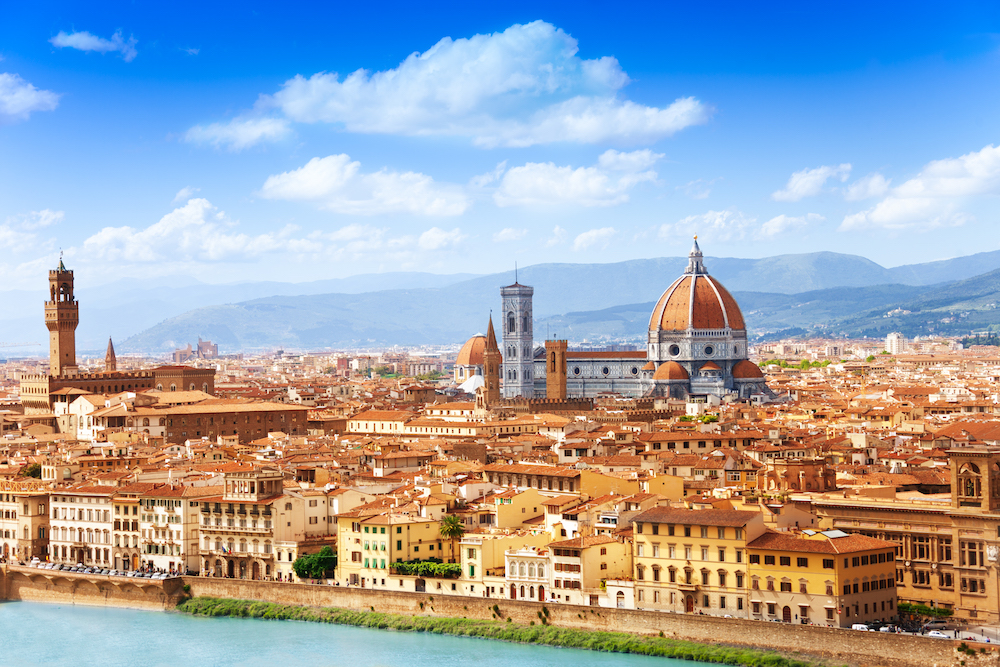 Florence is a city full of charm and beauty, beloved by travelers and art enthusiasts alike.
Florence is a city full of charm and beauty, beloved by travelers and art enthusiasts alike.
Florence has something for everyone, from its ancient buildings to the beautiful arteries of cobblestone that weave between them.
Whether you plan on spending just a few days in the picturesque Tuscan capital or an entire week exploring all the sites it holds, your visit will surely be unforgettable!
Today, we’re looking at some of the top things to do in Florence — from visiting iconic landmarks like Ponte Vecchio Bridge and Ufizzi Museum to enjoying a delicious gelato — so you can make the most of your next trip!
Cathedral of Santa Maria del Fiore
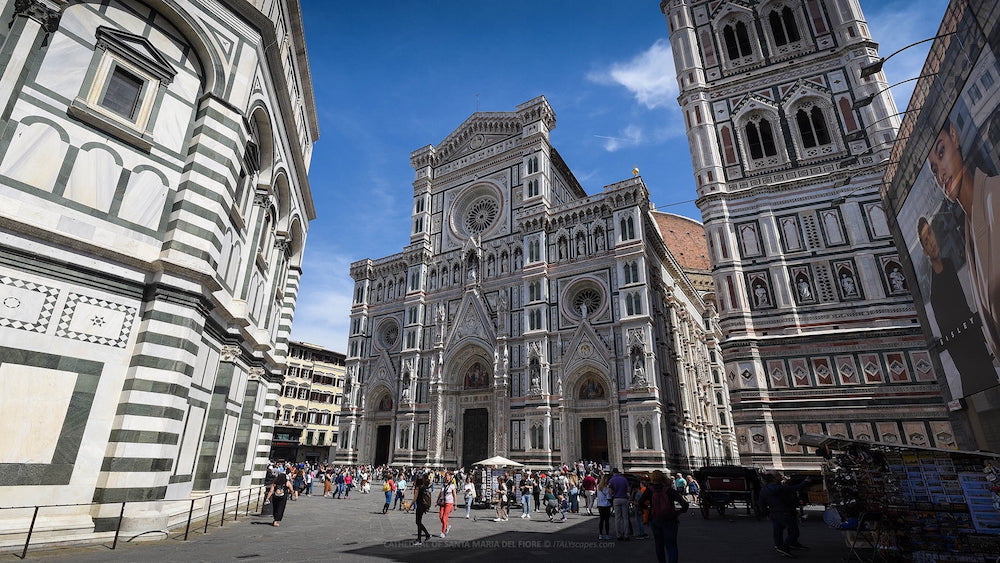 No trip to Florence is complete without visiting the Cathedral of Santa Maria del Fiore, commonly known as the Duomo.
No trip to Florence is complete without visiting the Cathedral of Santa Maria del Fiore, commonly known as the Duomo.
Completed in 1434 it is the most important landmark in Florence, as well as being the fourth-largest church in the world.
Most notable is its imposing dome crafted by Brunelleschi. He pushed the limits of what architecture could achieve by using new techniques to reduce the weight of a massive structure.
With over 4 million bricks, weighing over 40,000 tons, almost the size of half a football field across at the base, and standing over 10 stories high, it is the largest masonry structure in the world.
Baptistery of St. John
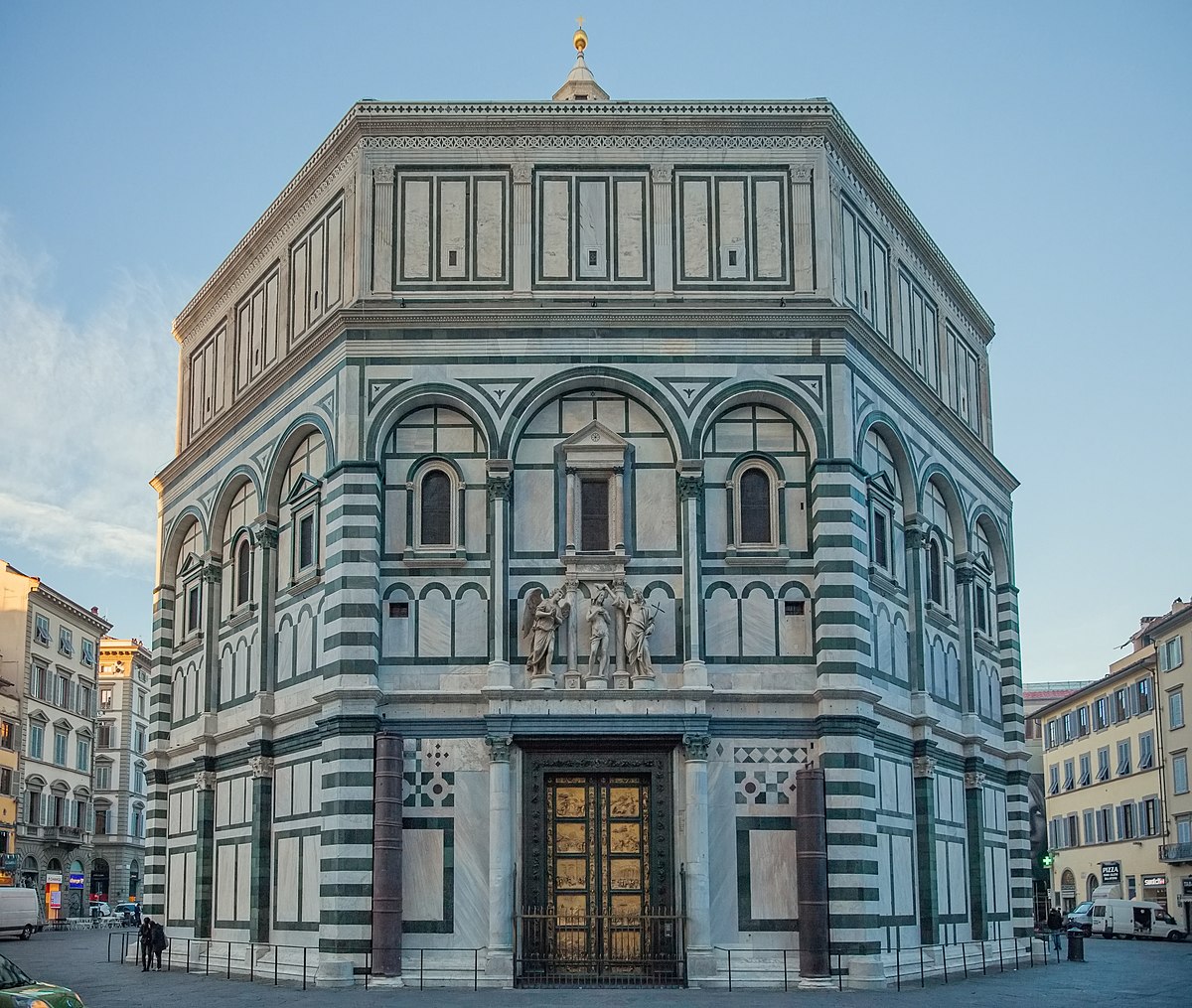 The Baptistery of St. John is one of the city’s oldest and most important religious sites. It is dedicated to St. John the Baptist, the patron saint of Florence.
The Baptistery of St. John is one of the city’s oldest and most important religious sites. It is dedicated to St. John the Baptist, the patron saint of Florence.
The Baptistery was constructed between the 11th and 12th centuries and is known for its octagonal shape, a common feature of early Christian baptisteries.
The building is made of white Carrara marble and is decorated with intricate mosaics and sculptures.
One of the most famous features of the Baptistery is the set of bronze doors known as the “Gates of Paradise.”
These doors were designed by the sculptor Lorenzo Ghiberti and depict scenes from the Old Testament.
They were originally created for the Florence Cathedral but were moved to the Baptistery in the 15th century.
The interior of the Baptistery is also adorned with beautiful mosaics, including a large mosaic of Christ in Majesty in the dome. The ceiling is decorated with frescoes depicting the Last Judgment, added in the 13th century.
Piazza della Repubblica
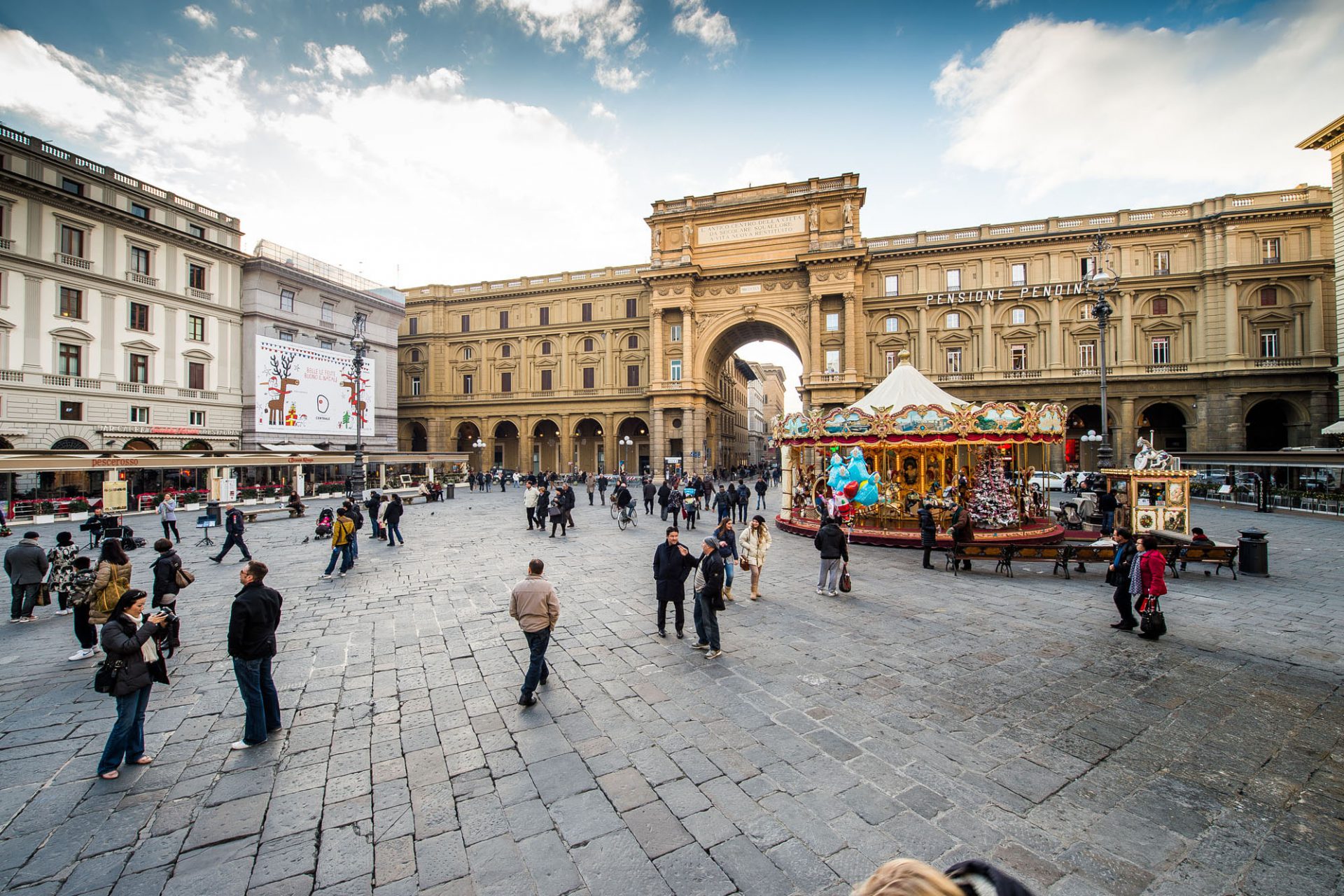 It is a bustling public space that has been the center of the city’s social and cultural life since ancient Roman times.
It is a bustling public space that has been the center of the city’s social and cultural life since ancient Roman times.
The square was originally known as the Forum of Florentia, and it served as the political, commercial, and cultural center of the Roman city.
During the medieval period, the square was the site of the city’s marketplace, surrounded by shops and buildings.
In the 19th century, the square was extensively renovated to commemorate the unification of Italy, and it was renamed Piazza della Repubblica.
During this time, many of the old medieval buildings were demolished to make way for new public buildings, including the Arch of Triumph, which stands at the center of the square.
Today, Piazza della Repubblica is a popular tourist destination and a city activity hub.
Cafes, restaurants, and shops surround it, and it is often used as a venue for cultural events and performances.
One of the most notable buildings in the square is the famous Caffè Gilli, which is one of the oldest cafes in Florence and has been in operation since 1733.
The square is also home to a beautiful carousel, which is a popular attraction for children and adults alike.
Dating from the 20th century, it is made of wood and consists of 20 horses and two king carriages. Be sure to look up to see the panels with paintings of different Italian cities.
Il Porcellino
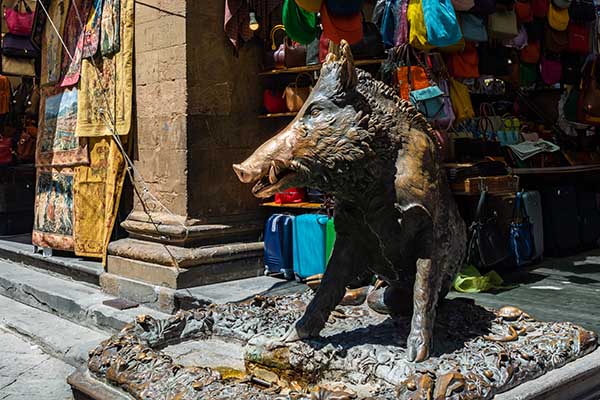 Il Porcellino is a bronze wild boar statue. It is a popular tourist attraction and is located in the Mercato Nuovo, or “New Market,” a historic outdoor market in the city.
Il Porcellino is a bronze wild boar statue. It is a popular tourist attraction and is located in the Mercato Nuovo, or “New Market,” a historic outdoor market in the city.
The statue was created in the 16th century by the Italian sculptor Pietro Tacca, a student of the famous artist Giambologna.
The boar was intended to be a tribute to the wild boars that once roamed the nearby forests and symbolized the city’s strength and power.
Legend has it that if you rub the boar’s snout and put a coin in its mouth, you will have good luck and ensure your return to Florence.
The tradition has been popular for centuries, and the statue’s snout is now shiny from the countless hands that have rubbed it over the years.
In addition to being a popular tourist attraction, Il Porcellino has also been the subject of many works of art, literature, and even film.
It is considered one of Florence’s most iconic and beloved symbols and is a must-see for anyone visiting the city.
Piazza della Signoria
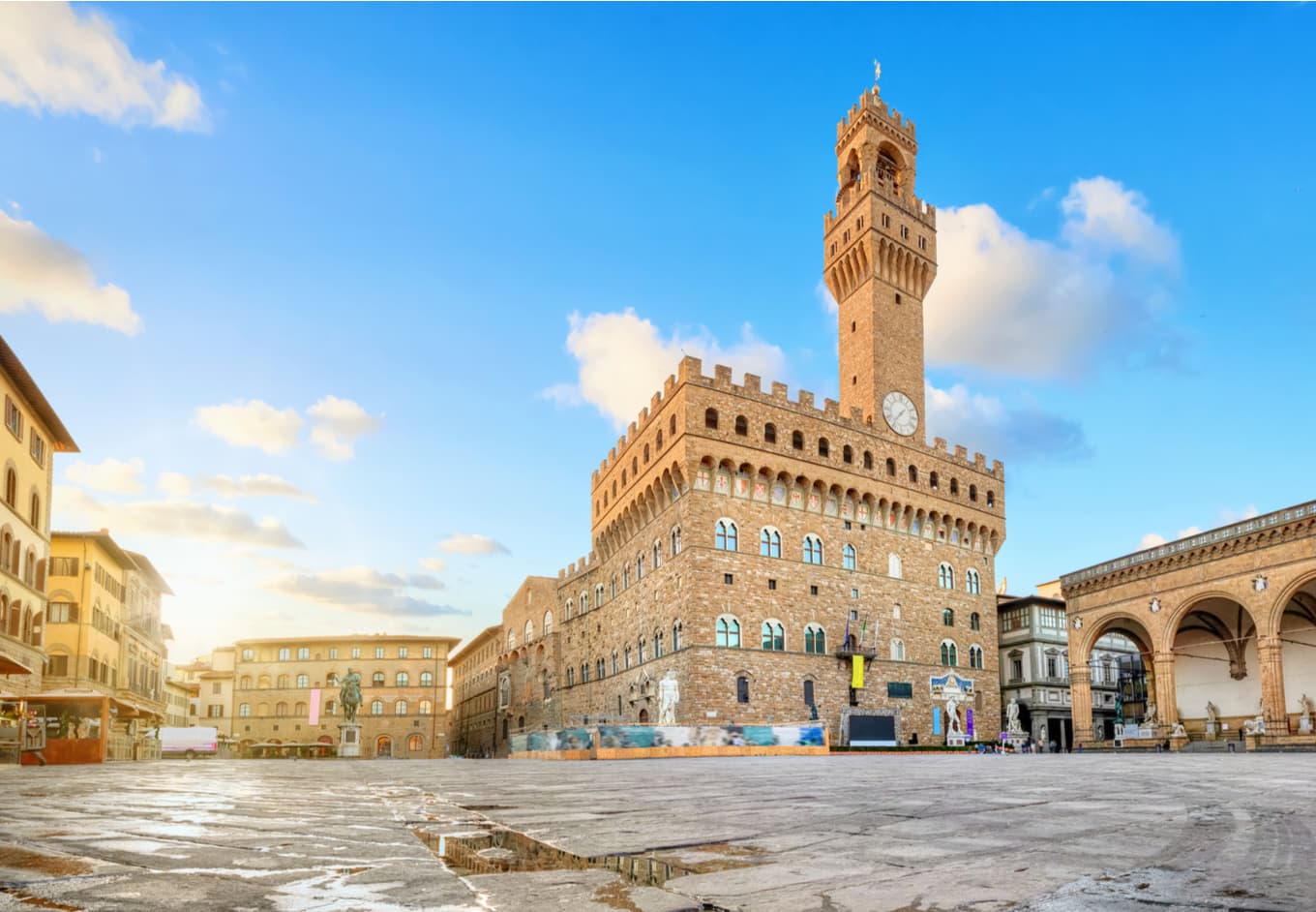 Piazza della Signoria is a famous square in the heart of Florence, Italy. It has been the center of the city’s political and cultural life for centuries and is one of the most important landmarks in Florence.
Piazza della Signoria is a famous square in the heart of Florence, Italy. It has been the center of the city’s political and cultural life for centuries and is one of the most important landmarks in Florence.
The square is named after the Palazzo della Signoria, which is the former name of the Palazzo Vecchio, the city’s town hall.
The Palazzo Vecchio is a massive, fortified building that was built in the 14th century and has been the seat of the Florentine government for centuries.
The Piazza della Signoria has been the site of many historic events throughout its history.
In 1497, the famous Dominican friar Savonarola burned books and works of art in the square to purge Florence of its decadence and corruption.
In 1504, Michelangelo’s David was unveiled in the square, and it stood there for over three centuries before it was moved to the Accademia Gallery in the 19th century.
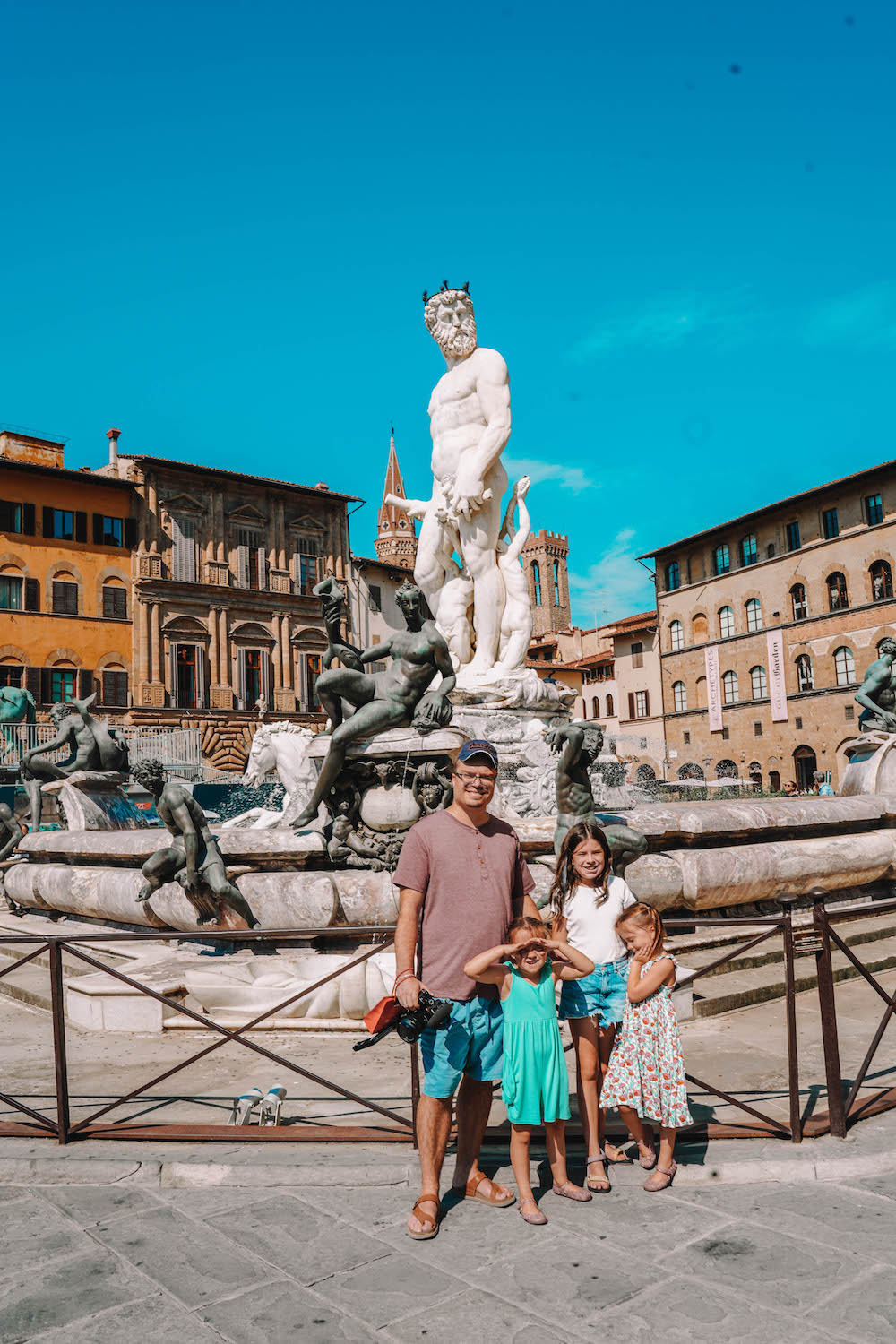 The square is also home to many famous statues and sculptures. One of the most famous is the bronze Cosimo I de’ Medici statue, created by the sculptor Giambologna in the 16th century.
The square is also home to many famous statues and sculptures. One of the most famous is the bronze Cosimo I de’ Medici statue, created by the sculptor Giambologna in the 16th century.
Another notable sculpture is the Fountain of Neptune, created by Bartolomeo Ammannati in the 16th century and depicts the Roman sea god Neptune.
The Loggia dei Lanzi is another famous feature of the Piazza della Signoria.
It is a covered outdoor gallery built in the 14th century and is home to many important Renaissance sculptures, including Cellini’s Perseus with the Head of Medusa and Giambologna’s Rape of the Sabine Women.
The Piazza della Signoria is also popular for tourists and locals. Cafes, restaurants, and shops surround it, and it is often used as a venue for cultural events and performances.
The square is transformed into an open-air cinema in the summer, where visitors can enjoy films under the stars.
Palazzo Vecchio
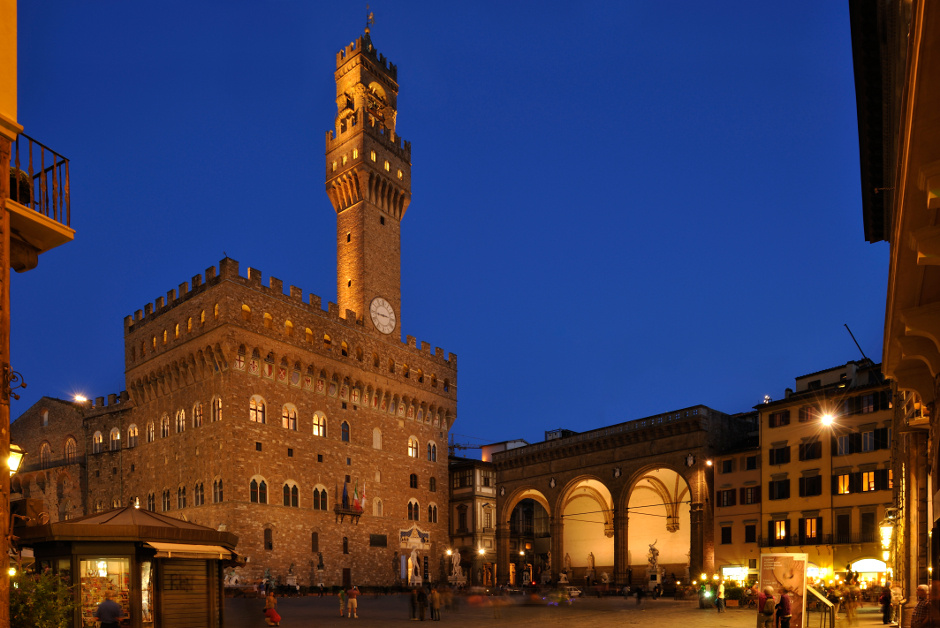 Palazzo Vecchio is a historic palace located in Piazza Della Signoria. It has been the seat of the Florentine government for centuries and is one of the most important landmarks in the city.
Palazzo Vecchio is a historic palace located in Piazza Della Signoria. It has been the seat of the Florentine government for centuries and is one of the most important landmarks in the city.
The palace was built in the 14th century, during the height of the Renaissance period. It was originally known as the Palazzo della Signoria and was the government headquarters for the Republic of Florence.
It was later renamed Palazzo Vecchio, or the “Old Palace,” after the Medici family took control of the city in the 16th century and moved their residence to the nearby Palazzo Pitti.
Palazzo Vecchio is a massive, fortified building that dominates the skyline of Florence. It has a unique mix of architectural styles, reflecting the different periods of its construction and renovations.
The exterior of the building features a tower and a clock, as well as ornate decorations and sculptures.
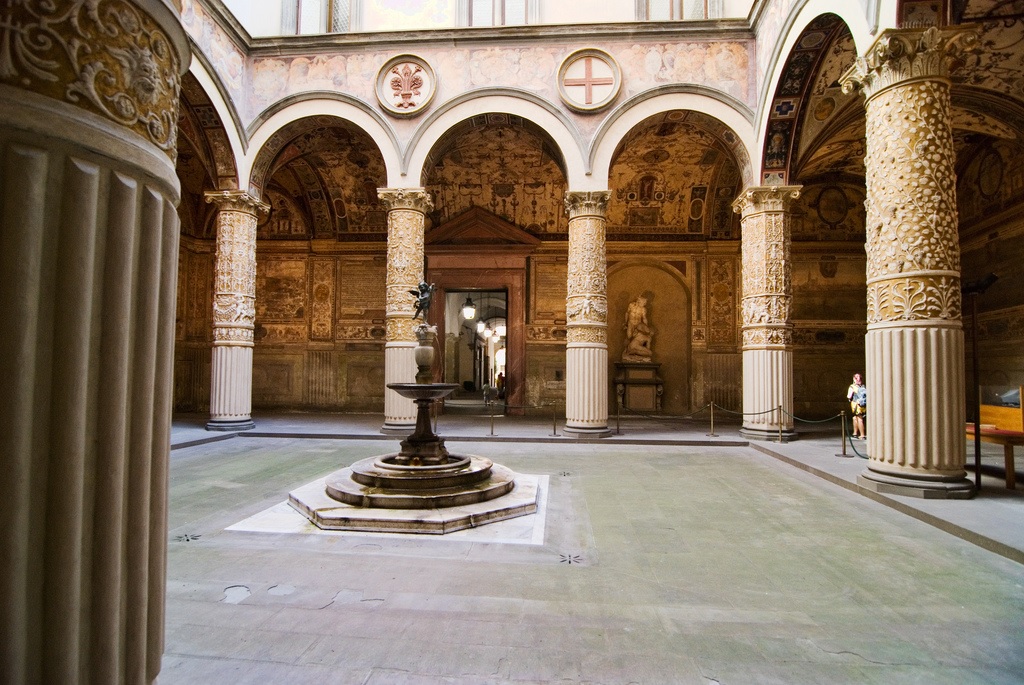 The interior of Palazzo Vecchio is equally impressive, with grand halls, elegant chambers, and exquisite artwork.
The interior of Palazzo Vecchio is equally impressive, with grand halls, elegant chambers, and exquisite artwork.
The Hall of the Five Hundred, also known as the Sala dei Cinquecento, is one of the most famous rooms in the palace. It is a massive hall used for public meetings and assemblies.
It is adorned with frescoes and sculptures by some of the greatest artists of the Renaissance, including Leonardo da Vinci, Michelangelo, and Giorgio Vasari.
Other notable rooms in the palace include the Chapel of the Signoria, which features beautiful frescoes by Agnolo Gaddi, and the Quartieri Monumentali, which are the private apartments of the Medici family.
One of the most famous features of Palazzo Vecchio is the tower, which offers stunning views of Florence and the surrounding countryside.
The tower was originally built as a defensive structure but was later used as a prison and private residence for some of the city’s rulers.
Palazzo Vecchio is also home to many famous works of art, including Michelangelo’s Victory, a statue depicting the goddess Nike, and Donatello’s Judith and Holofernes, a bronze sculpture that portrays the biblical story of Judith beheading the Assyrian general Holofernes.
Gucci Cafe
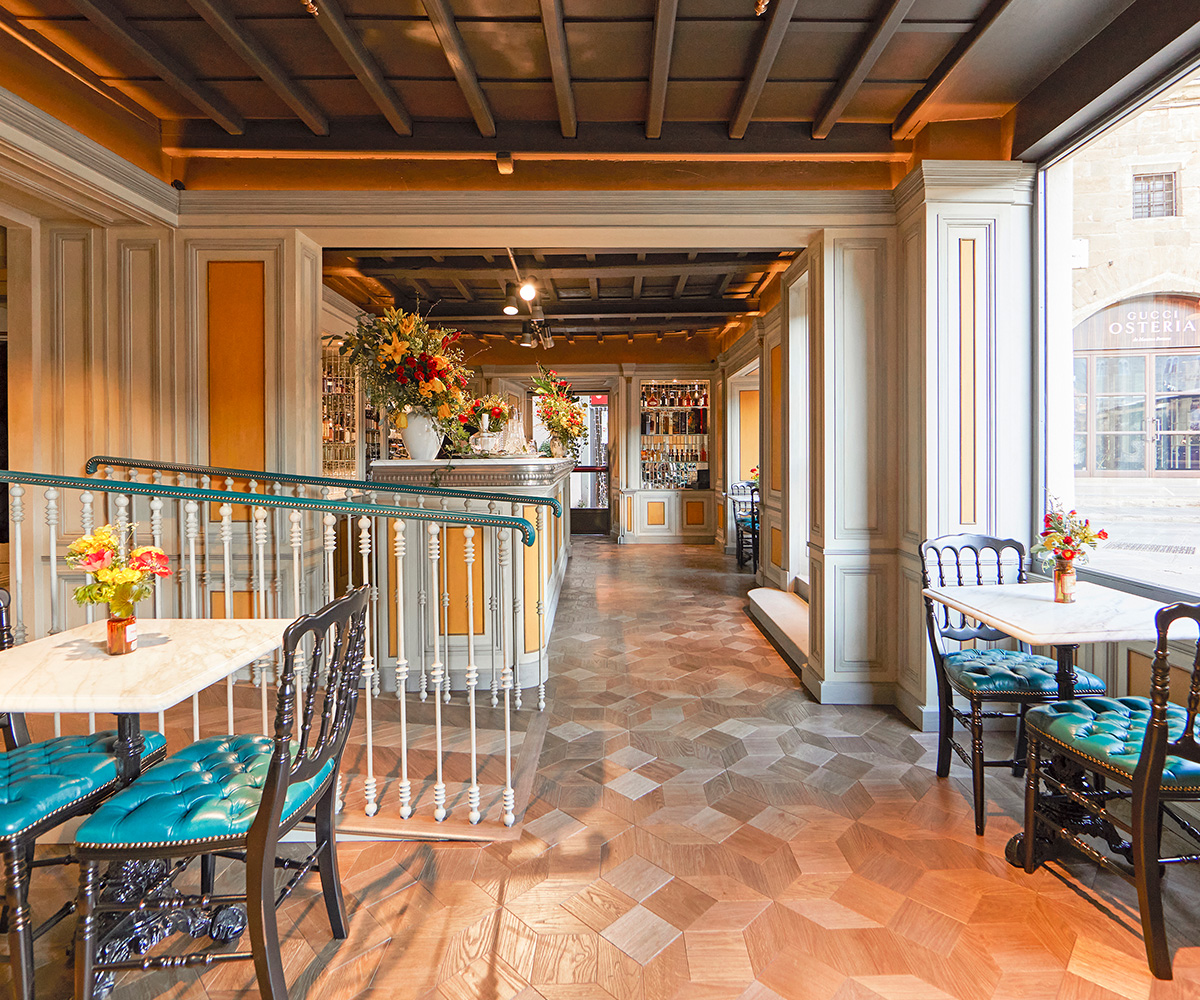 Perched just a stone’s throw away at the opposite end of Piazza della Signoria is the Gucci Cafe. Owned by the renowned Florentine designer brand, this upscale cocktail lounge offers an exquisite selection of signature drinks with a stunning view of the illuminated square at night.
Perched just a stone’s throw away at the opposite end of Piazza della Signoria is the Gucci Cafe. Owned by the renowned Florentine designer brand, this upscale cocktail lounge offers an exquisite selection of signature drinks with a stunning view of the illuminated square at night.
Uffizi Gallery
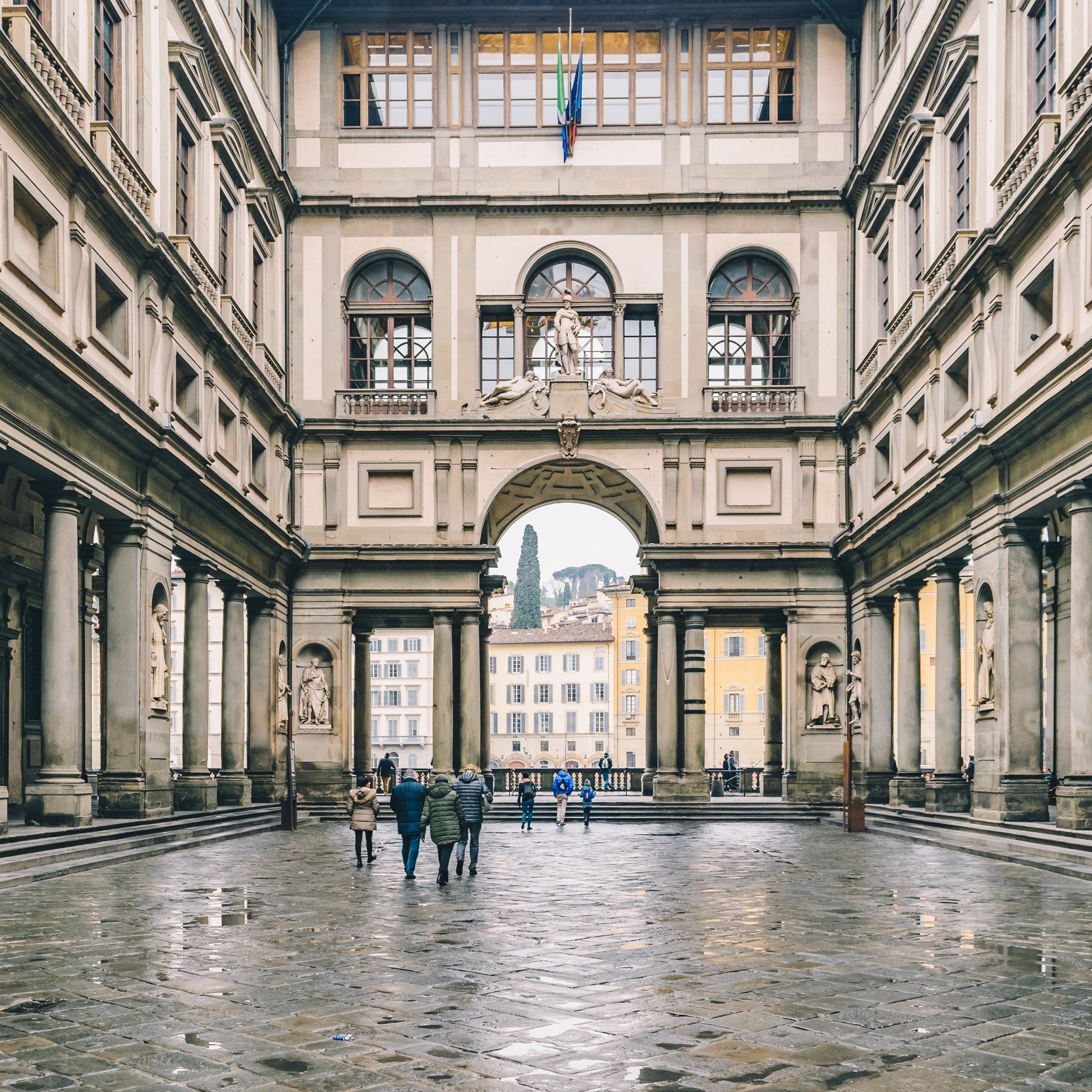 The Uffizi Gallery is a world-renowned art museum located in Florence, Italy. It is one of the world’s oldest and most important art museums, housing an incredible collection of Renaissance and Baroque artwork.
The Uffizi Gallery is a world-renowned art museum located in Florence, Italy. It is one of the world’s oldest and most important art museums, housing an incredible collection of Renaissance and Baroque artwork.
The Uffizi Gallery was originally built in the mid-16th century as offices for the Medici family, who were the rulers of Florence at the time.
The building was designed by the architect Giorgio Vasari and features a long, U-shaped layout intended to house government offices and administrative spaces.
In the 17th century, the Medici family converted part of the building into an art gallery, displaying many of the works of art that they had collected over the years.
Over time, the collection grew, and the Uffizi Gallery became one of the most important art museums in the world.
Today, the Uffizi Gallery is home to an incredible collection of artwork, including paintings, sculptures, and other works of art from the Renaissance and Baroque periods.
The museum houses works by some of the greatest artists, including Leonardo da Vinci, Michelangelo, Raphael, Botticelli, Caravaggio, and many others.
One of the most famous works in the Uffizi Gallery is Botticelli’s “The Birth of Venus,” a stunning painting that depicts the goddess Venus emerging from the sea.
This painting is considered one of the greatest masterpieces of the Renaissance period and is a must-see for anyone visiting the museum.
Another famous work in the Uffizi Gallery is Leonardo da Vinci’s “Annunciation,” a painting that portrays the moment the angel Gabriel tells Mary that she will give birth to Jesus.
This painting is one of the earliest works by da Vinci and is a testament to his incredible talent and skill as an artist.
Accademia Gallery
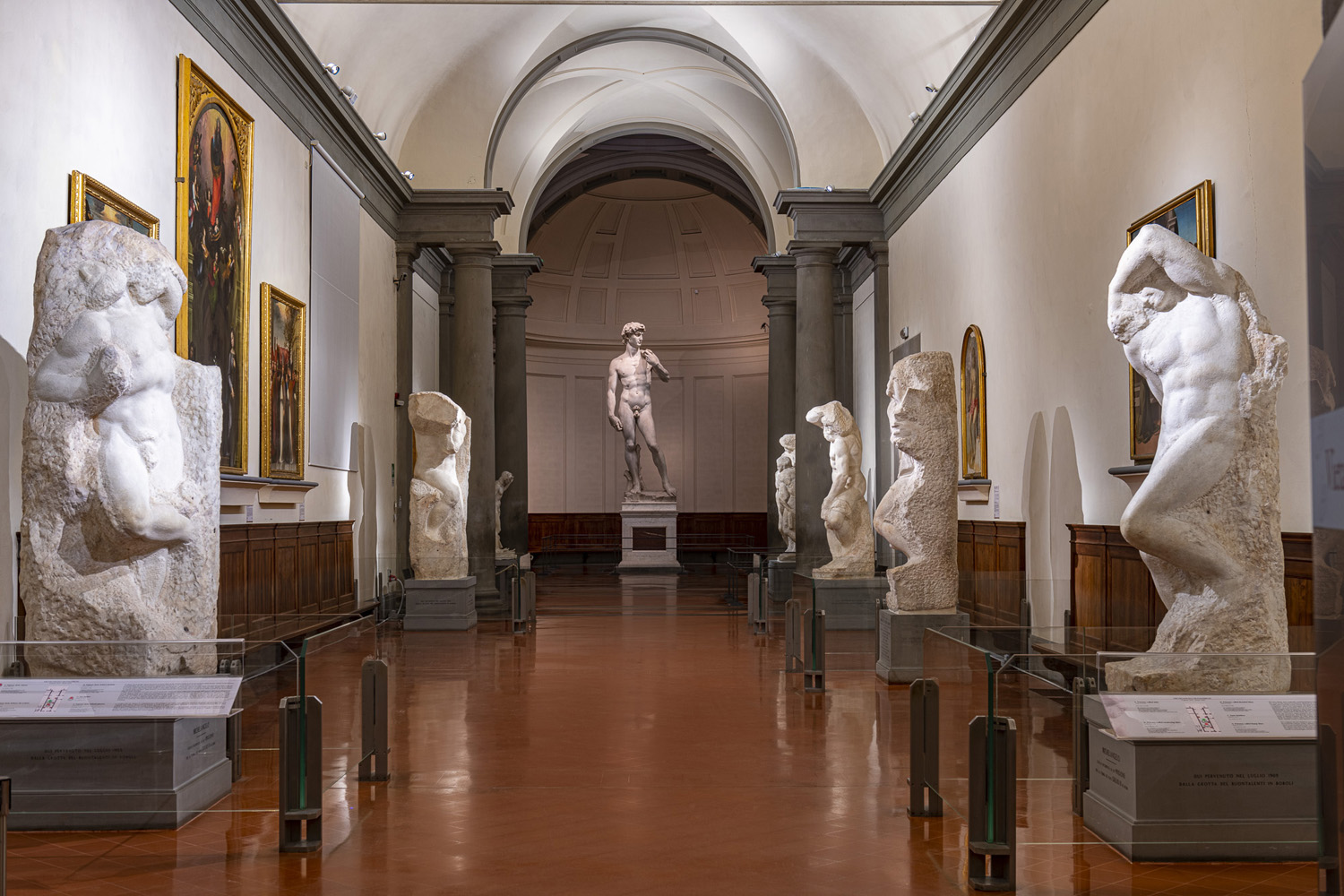 The Accademia Gallery is a world-renowned art museum located in the heart of Florence, Italy.
The Accademia Gallery is a world-renowned art museum located in the heart of Florence, Italy.
The museum is famous for its collection of Renaissance art and is home to some of history’s most iconic works of art.
The centerpiece of the Accademia Gallery is undoubtedly Michelangelo’s David, a stunning marble statue that stands over 17 feet tall and weighs over 6 tons.
The sculpture is considered a masterpiece of Renaissance art and is widely regarded as one of history’s most important works.
In addition to the David, the Accademia Gallery also features a number of other works by Michelangelo, including the unfinished sculptures known as the Slaves, as well as several other Renaissance masterpieces.
Visitors can also admire works by other famous artists such as Botticelli, Ghirlandaio, and Pontormo.
The Accademia Gallery is housed in a beautiful building originally built in the 14th century as a hospital.
The building has undergone several renovations over the years, and today it is a stunning example of Renaissance architecture.
One of the benefits of visiting the Accademia Gallery is that it is a relatively small museum, so visitors can easily see all of the major works of art in a relatively short amount of time.
However, due to its popularity, the museum can get quite crowded, so booking tickets in advance or arriving early in the day is recommended to avoid long lines.
Ponte Vecchio
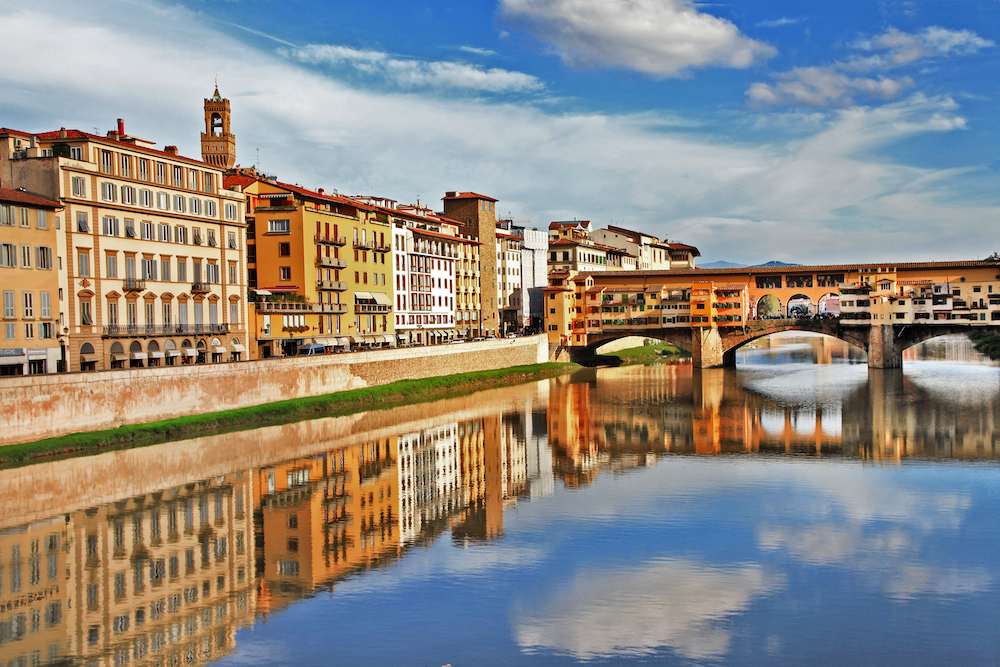
Ponte Vecchio is a medieval bridge in Florence, Italy that spans the Arno River.
It is one of the city’s most iconic landmarks and is famous for its unique architecture and the many shops that line the bridge.
The history of Ponte Vecchio can be traced back to Roman times when the area was first settled.
The original bridge was constructed in the 10th century but was destroyed by a flood in 1117. The current bridge was built in 1345 and has been continuously used.
One of the unique features of Ponte Vecchio is the row of shops that line the bridge.
Originally, these shops were occupied by butchers and other merchants, but in the 16th century, they were replaced by goldsmiths and jewelers.
Today, the shops still sell a variety of jewelry and other luxury items, making Ponte Vecchio a popular shopping destination for tourists.
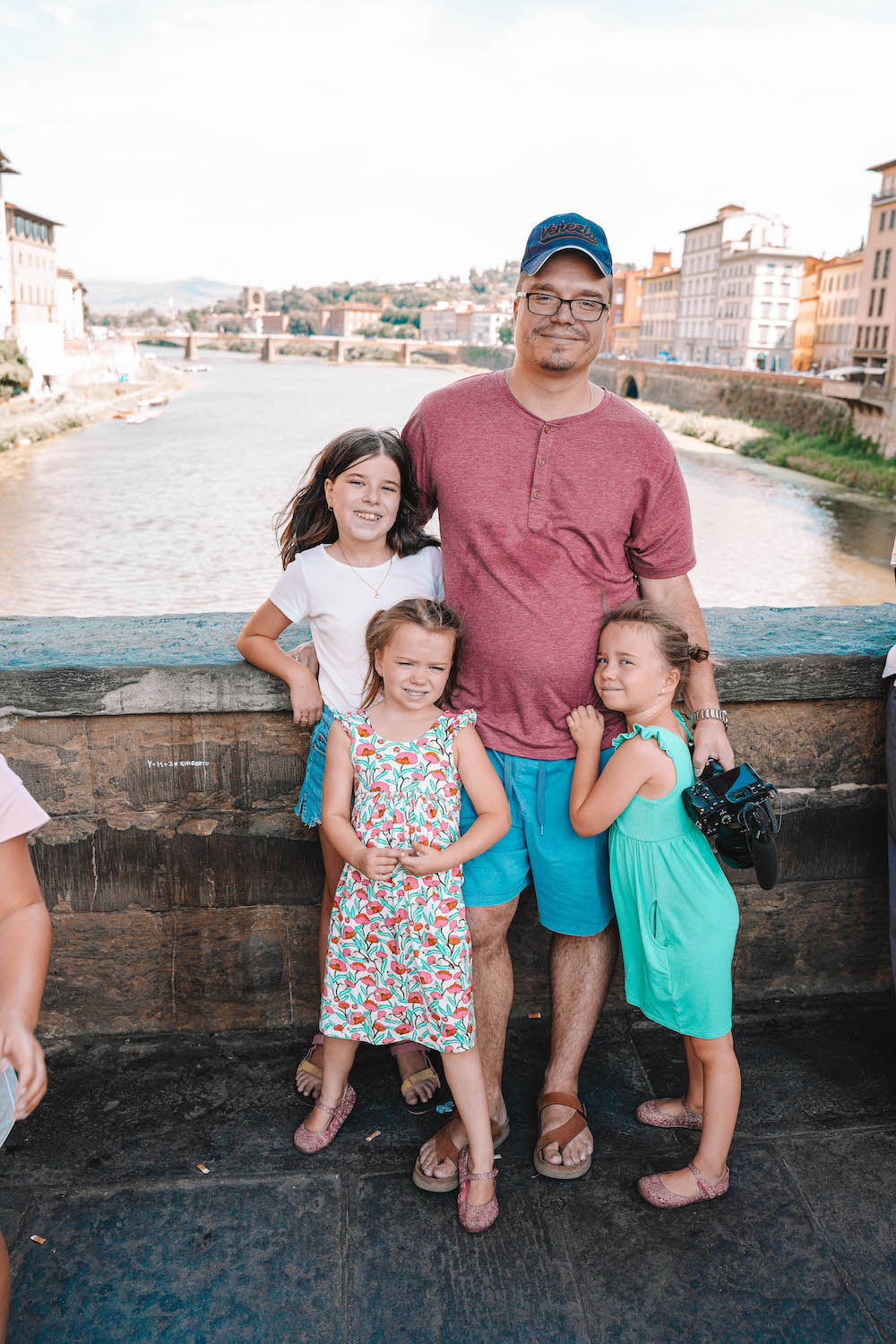 Another notable feature of Ponte Vecchio is the Vasari Corridor, a covered walkway along the top of the bridge.
Another notable feature of Ponte Vecchio is the Vasari Corridor, a covered walkway along the top of the bridge.
The corridor was built in the 16th century at the request of the Medici family, who wanted a private route to their offices in the Palazzo Pitti on the other side of the river.
The corridor is decorated with paintings and other works of art and is not open to the public.
During World War II, the retreating German army did not destroy the only bridge in Florence, thanks to the intervention of a German officer who disobeyed orders to destroy it.
The bridge has also played a significant role in the city’s cultural and political life over the centuries. It was the site of public spectacles and ceremonies, including the pageants held during the Medici era.
Today, Ponte Vecchio remains one of Florence’s most popular tourist attractions.
Visitors can take a leisurely stroll across the bridge, enjoying the stunning views of the Arno River and the surrounding city.
They can also explore the many shops that line the bridge, admiring the exquisite jewelry and other luxury items on display.
Gelateria dei Neri
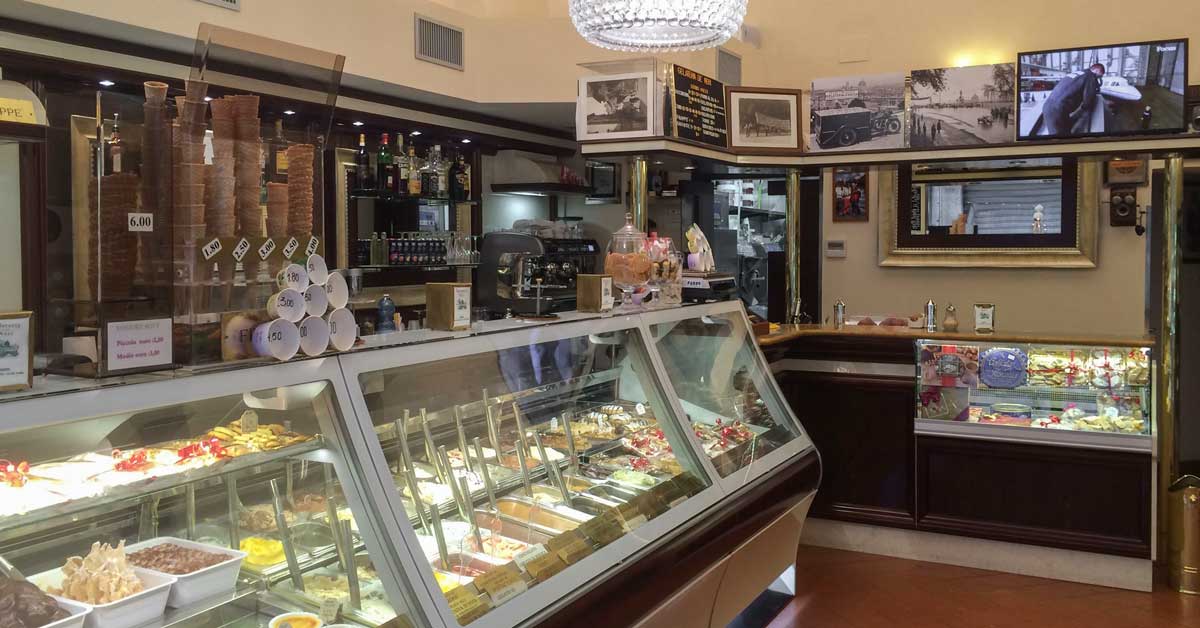 Gelateria dei Neri is a popular gelato shop. It is known for serving some of the best gelato in the city, and it is a favorite among locals and tourists alike.
Gelateria dei Neri is a popular gelato shop. It is known for serving some of the best gelato in the city, and it is a favorite among locals and tourists alike.
The gelateria was founded in 1989 by the Neri family, and it has been serving up delicious gelato ever since. The shop is located on Via dei Neri, a charming street in the historic center of Florence lined with shops, cafes, and restaurants.
One of the things that sets Gelateria dei Neri apart from other gelato shops is the quality of the ingredients they use.
The Neri family is dedicated to using only the freshest and highest quality ingredients in their gelato, including fresh fruits, nuts, and other natural ingredients.
In addition to classic flavors like chocolate and vanilla, Gelateria dei Neri offers various unique and creative flavors that change with the seasons.
Their most popular flavors include pistachio, hazelnut, stracciatella, and raspberry.
The gelato at Gelateria dei Neri is made fresh daily, using traditional methods handed down through generations of Italian gelato makers.
The result is a creamy and flavorful gelato that will satisfy even the most discerning taste buds.
In addition to gelato, Gelateria dei Neri also offers a selection of sorbets, pastries, and other sweet treats.
They also have a few tables outside the shop where customers can sit and enjoy their gelato while taking in the sights and sounds of Florence.
Basilica di San Lorenzo
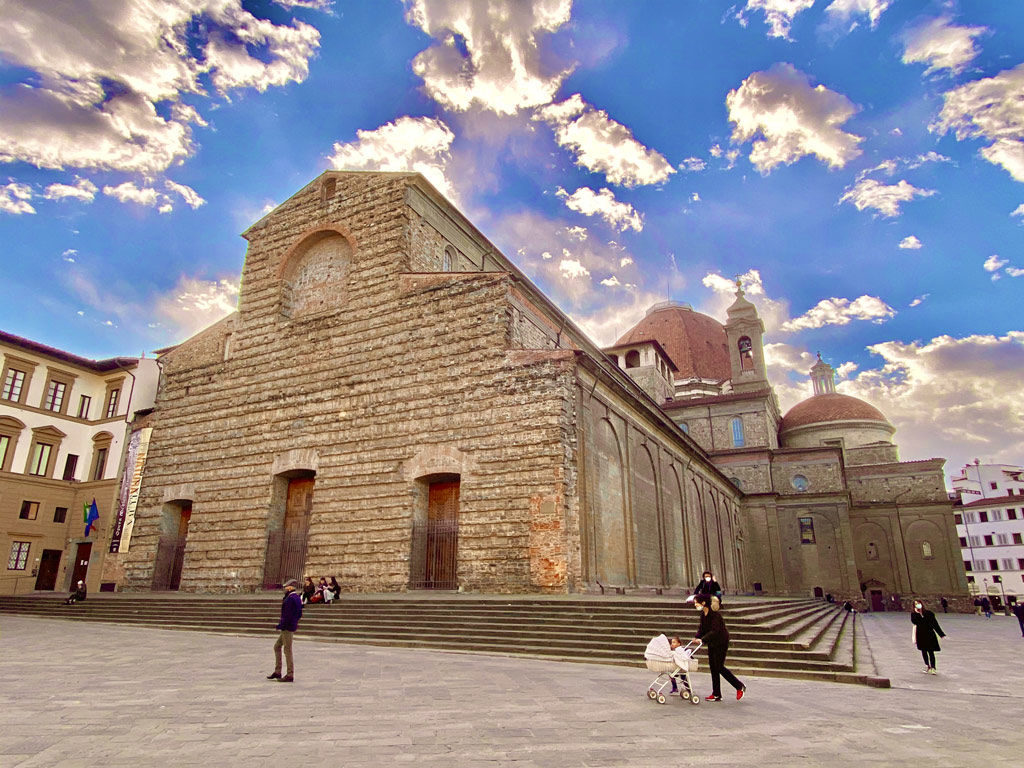 The Basilica di San Lorenzo is one of the largest and oldest churches in the city, and it has a rich history that dates back to the 4th century.
The Basilica di San Lorenzo is one of the largest and oldest churches in the city, and it has a rich history that dates back to the 4th century.
The original church was built on the site in the 4th century and was dedicated to Saint Lawrence, a Christian martyr burned alive on a gridiron.
Over the centuries, the church was expanded and renovated multiple times, and it eventually became a major center of religious and cultural life in Florence.
One of the most notable features of the Basilica di San Lorenzo is its beautiful facade.
Michelangelo designed the facade in the 16th century but was never completed due to a lack of funds.
Despite this, the facade still remains an impressive work of art, featuring a unique combination of classical and Renaissance elements.
Inside the church, visitors can admire a number of beautiful works of art, including frescoes by Filippo Lippi and sculptures by Donatello.
The church also contains a number of important tombs, including the tombs of several members of the powerful Medici family, who were major patrons of the arts in Renaissance Florence.
Another highlight of the Basilica di San Lorenzo is the Medici Chapel, a separate space within the church that was built as a mausoleum for members of the Medici family.
The chapel features stunning marble sculptures by Michelangelo, including the famous “Night” and “Day” sculptures.
Basilica of Santa Croce
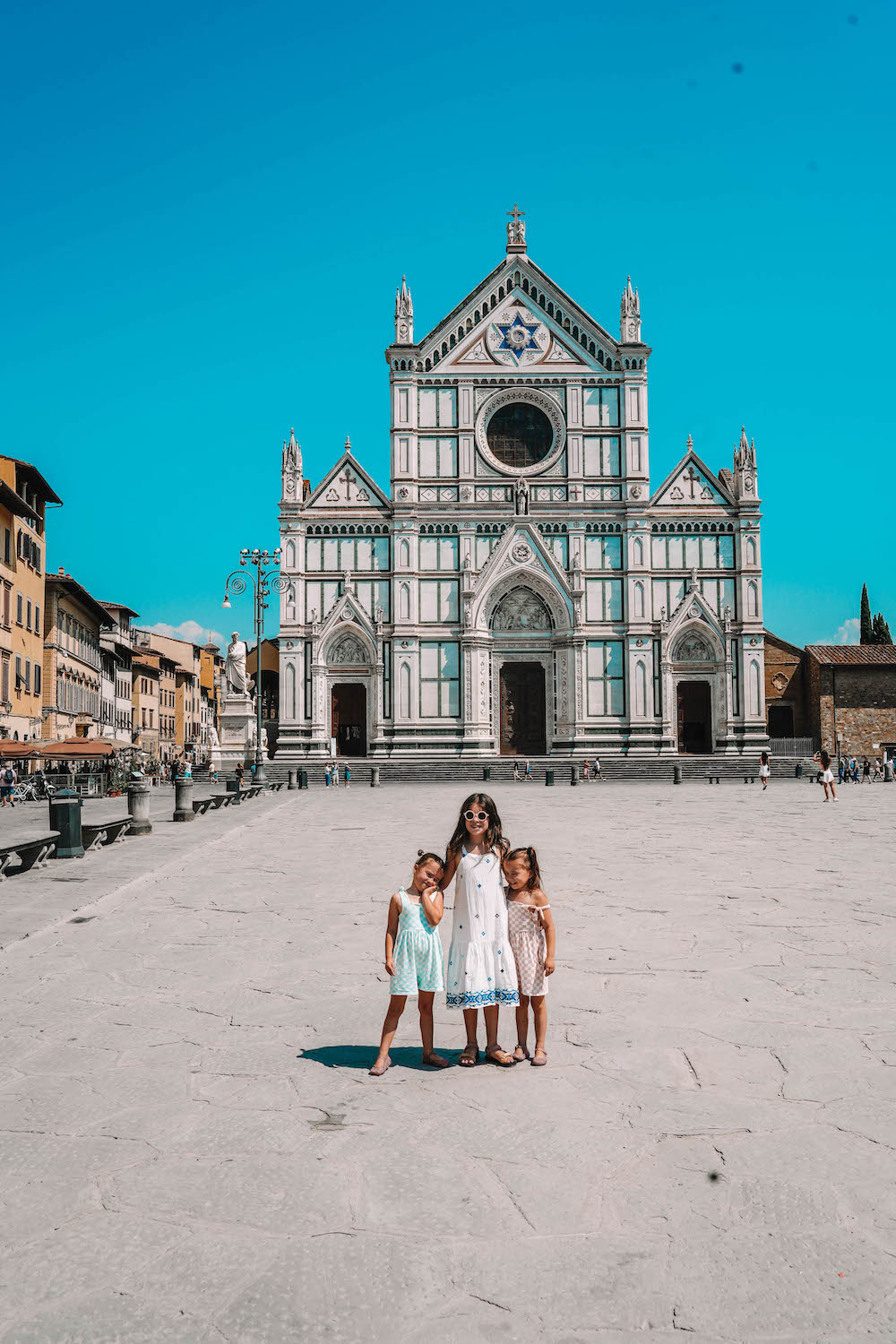 The Basilica of Santa Croce is one of the largest Franciscan churches in the world, and it is famous for its stunning Gothic architecture, impressive works of art, and historical significance.
The Basilica of Santa Croce is one of the largest Franciscan churches in the world, and it is famous for its stunning Gothic architecture, impressive works of art, and historical significance.
The church was founded in the 13th century and was designed in the Gothic style by the architect Arnolfo di Cambio.
It took over 100 years to complete, and the result is a stunning example of Gothic architecture with its intricate stone carvings, stained glass windows, and soaring arches.
One of the most impressive features of the Basilica of Santa Croce is its collection of art and tombs.
The church is home to a number of beautiful frescoes and paintings by artists such as Giotto, Cimabue, and Donatello.
The tombs of many famous Italians are also located within the church, including Michelangelo, Galileo Galilei, and Niccolò Machiavelli.
Another notable feature of the Basilica of Santa Croce is its beautiful cloister. The cloister is a peaceful and serene space, with its quiet gardens, ancient stone walls, and beautiful frescoes.
It is a popular spot for visitors to relax and take in the beauty and history of the church.
In addition to its architectural and artistic treasures, the Basilica of Santa Croce has played an important role in the history of Florence.
It was the site of many important events and ceremonies, including the funeral of Dante Alighieri, the famous Italian poet, in 1321.
Basilica of Santa Maria Novella
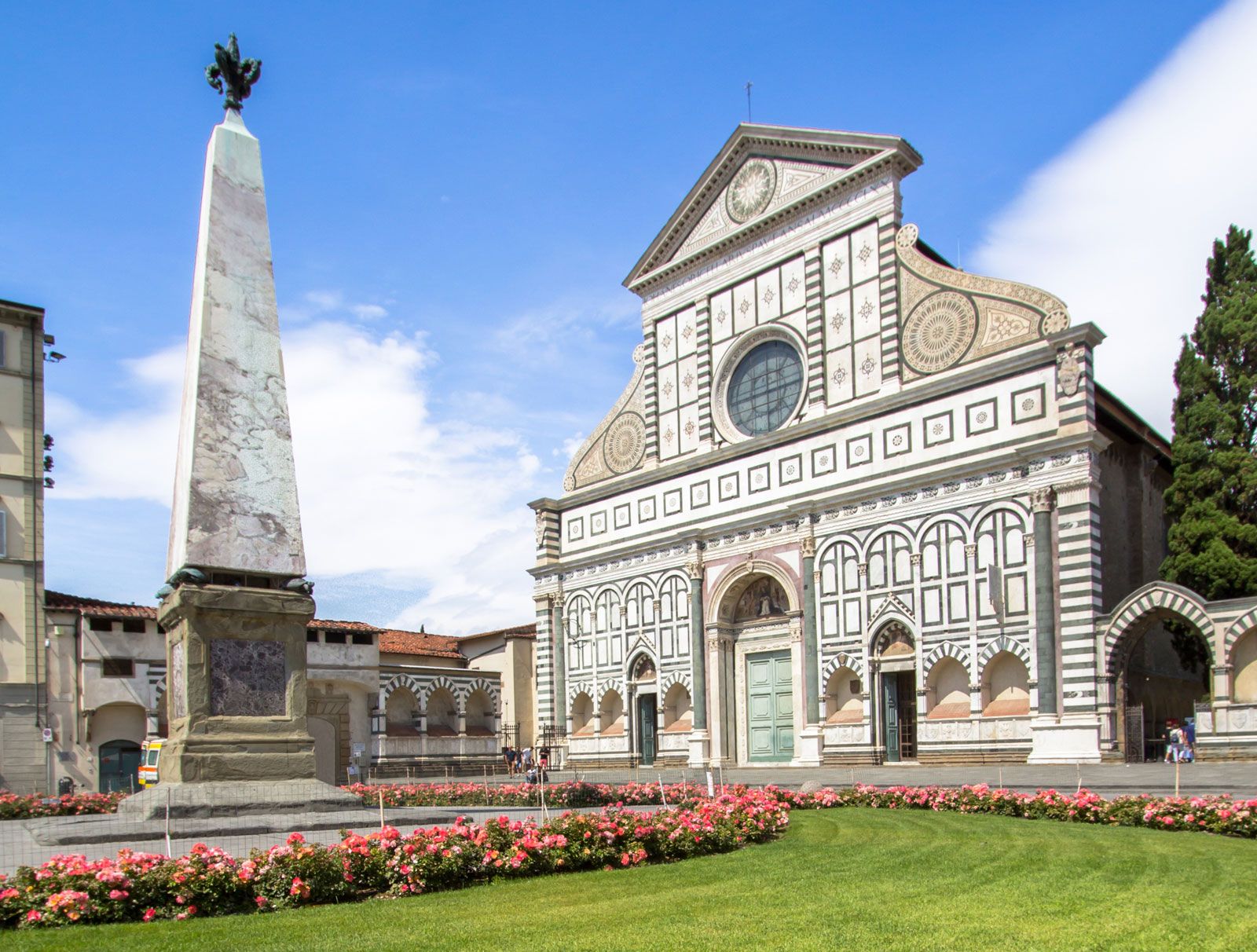 The Basilica of Santa Maria Novella is a beautiful church located in the heart of Florence, Italy.
The Basilica of Santa Maria Novella is a beautiful church located in the heart of Florence, Italy.
It is one of the city’s most important religious and artistic landmarks, known for its stunning architecture, rich history, and collection of art and artifacts.
The church was constructed in the 13th century and features a stunning Gothic facade that is adorned with intricate carvings and colorful frescoes.
The interior of the church is equally impressive, with soaring vaulted ceilings, intricate frescoes, and stunning marble floors.
One of the highlights of the Basilica of Santa Maria Novella is its collection of art and artifacts.
The church is home to a number of important works by some of the most famous artists of the Renaissance, including Giotto, Masaccio, and Filippo Lippi.
Visitors can admire stunning frescoes, sculptures, and paintings that tell the story of the church’s rich history and cultural significance.
Another notable feature of the Basilica of Santa Maria Novella is its beautiful cloisters dating back to the 14th century.
The cloisters feature stunning arches and columns and a peaceful garden that provides a tranquil escape from the bustling streets of Florence.
Palazzo Pitti
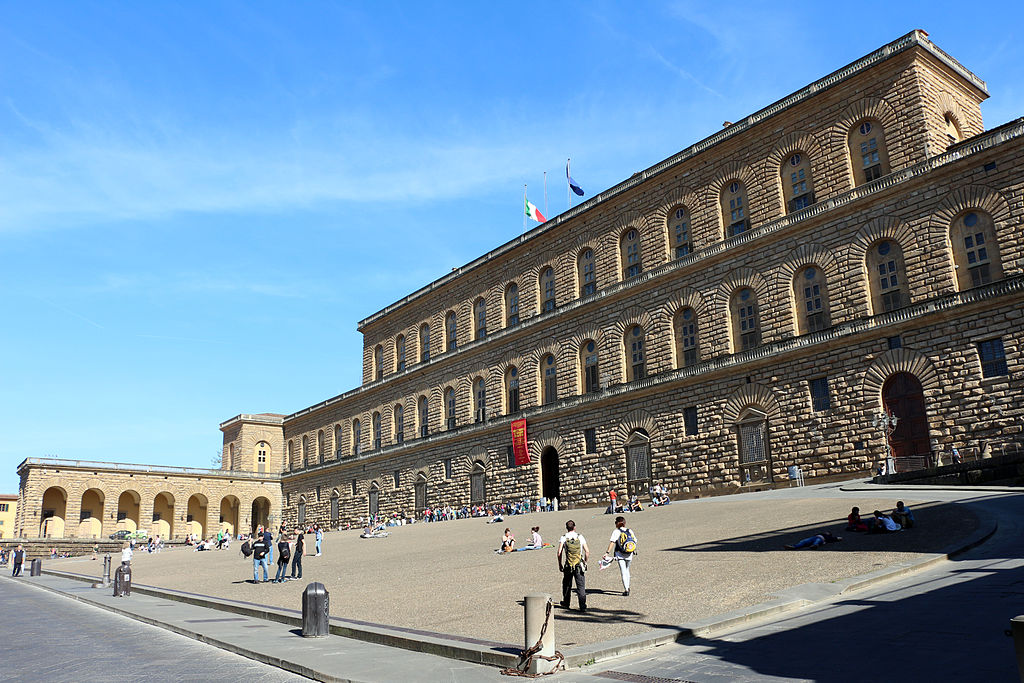 Palazzo Pitti is a magnificent Renaissance palace located in Florence, Italy. The palace was built in the 15th century for the wealthy merchant Luca Pitti.
Palazzo Pitti is a magnificent Renaissance palace located in Florence, Italy. The palace was built in the 15th century for the wealthy merchant Luca Pitti.
It was later purchased by the powerful Medici family, who made significant additions and renovations to the building.
Today, Palazzo Pitti is a major cultural center in Florence and houses several important museums and art collections.
The palace comprises several buildings and courtyards, each with its unique character and history.
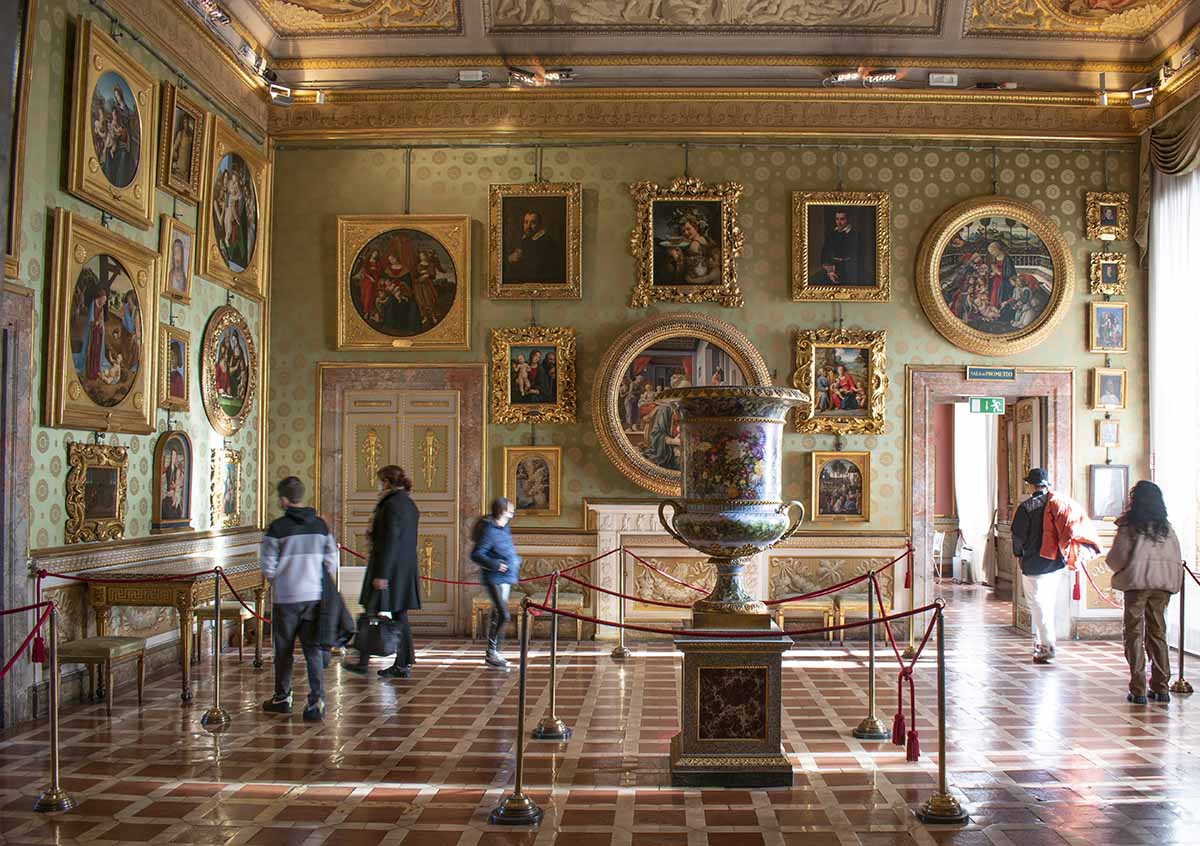 One of the most notable museums in Palazzo Pitti is the Palatine Gallery, which houses a vast collection of Renaissance art, including works by Raphael, Titian, and Rubens.
One of the most notable museums in Palazzo Pitti is the Palatine Gallery, which houses a vast collection of Renaissance art, including works by Raphael, Titian, and Rubens.
The gallery is in the palace’s main building and features beautifully decorated rooms with frescoes, stucco, and gilt decorations.
Another museum housed within Palazzo Pitti is the Museum of Costume and Fashion, which showcases a collection of historic clothing and accessories from the 18th to the 20th centuries.
The museum is located in the palace’s former royal apartments and features a stunning collection of garments, textiles, and accessories.
The palace also features several other museums and exhibitions, including the Silver Museum, which houses a collection of precious objects such as jewelry, silverware, and precious stones.
The Museum of Porcelain, which showcases a collection of fine ceramics from around the world.
Boboli Gardens
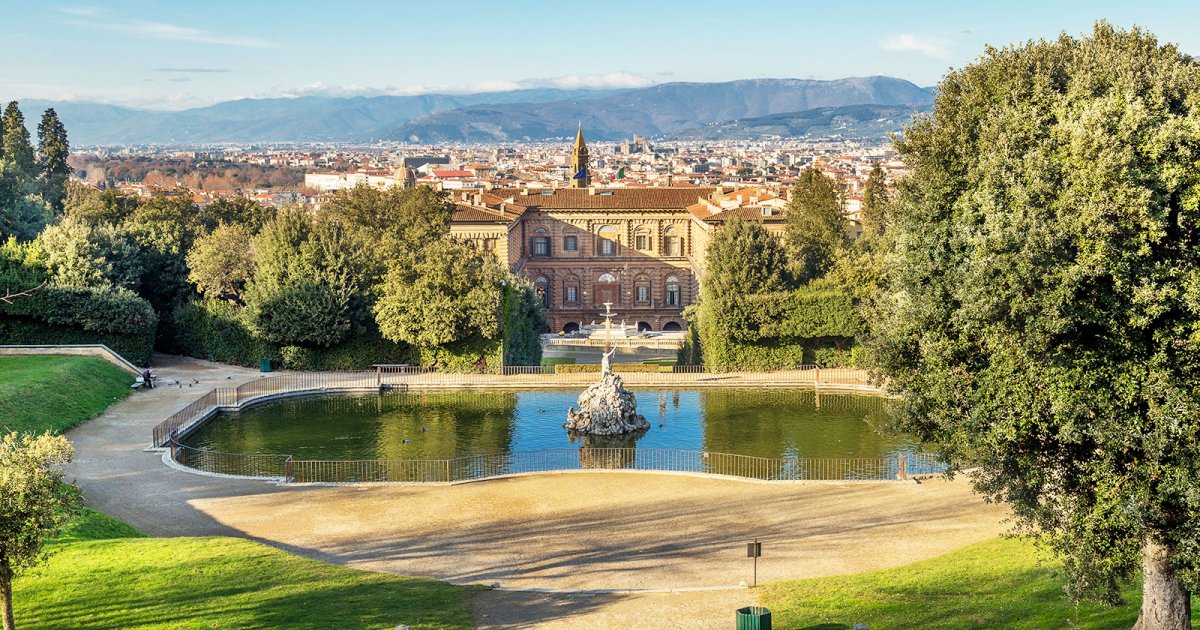 The gardens were created in the 16th century for the Medici family and have since become one of the city’s most popular attractions.
The gardens were created in the 16th century for the Medici family and have since become one of the city’s most popular attractions.
The gardens are located behind the Pitti Palace, which was the residence of the Medici family.
The gardens were designed in the Italian Renaissance style and feature a variety of formal gardens, fountains, and sculptures, as well as a large amphitheater and a small lake.
One of the most impressive features of the Boboli Gardens is the Grotto of Buontalenti.
This artificial cave is decorated with intricate mosaics, sculptures, and frescoes and was designed to be a place of relaxation and reflection for the Medici family.
Another highlight of the gardens is the Fountain of Neptune, which features a large statue of the sea god surrounded by smaller figures and animals.
The fountain is located in a large circular basin and is surrounded by beautiful landscaping and views of the city.
The gardens are also home to a number of beautiful sculptures and statues, including works by artists such as Giambologna and Pietro Tacca.
These sculptures are spread throughout the gardens and provide visitors with a glimpse into the artistic heritage of Florence.
Piazza Michelangelo
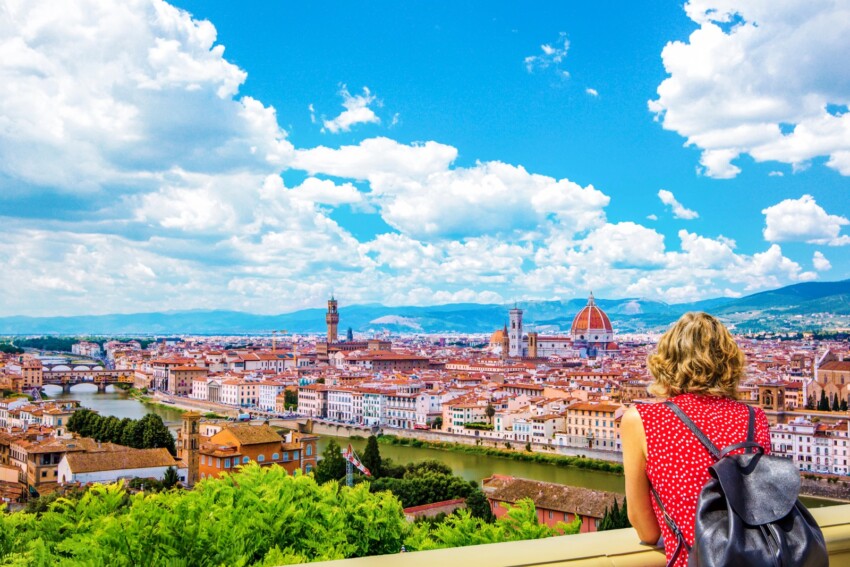 Piazza Michelangelo is a beautiful square. The square offers stunning panoramic city views and is a popular destination for tourists and locals.
Piazza Michelangelo is a beautiful square. The square offers stunning panoramic city views and is a popular destination for tourists and locals.
The square is named after the famous Italian Renaissance artist Michelangelo, known for his iconic sculptures such as the David and the Pietà.
A bronze replica of Michelangelo’s David can be found in the center of the square, providing a visual link to the city’s rich artistic heritage.
In addition to its impressive views and artistic connections, Piazza Michelangelo is also home to several cafes, restaurants, and shops, making it a popular destination for sightseeing and leisure.
Visitors can stroll around the square and enjoy a coffee or gelato while taking in the breathtaking views of Florence.
One of the best times to visit Piazza Michelangelo is at sunset, when the sky is painted with a stunning array of colors and the city is bathed in a warm, golden light.
The square is also a popular spot for photographers, who come to capture the iconic views of Florence and the surrounding countryside.
Abbazia di San Miniato al Monte
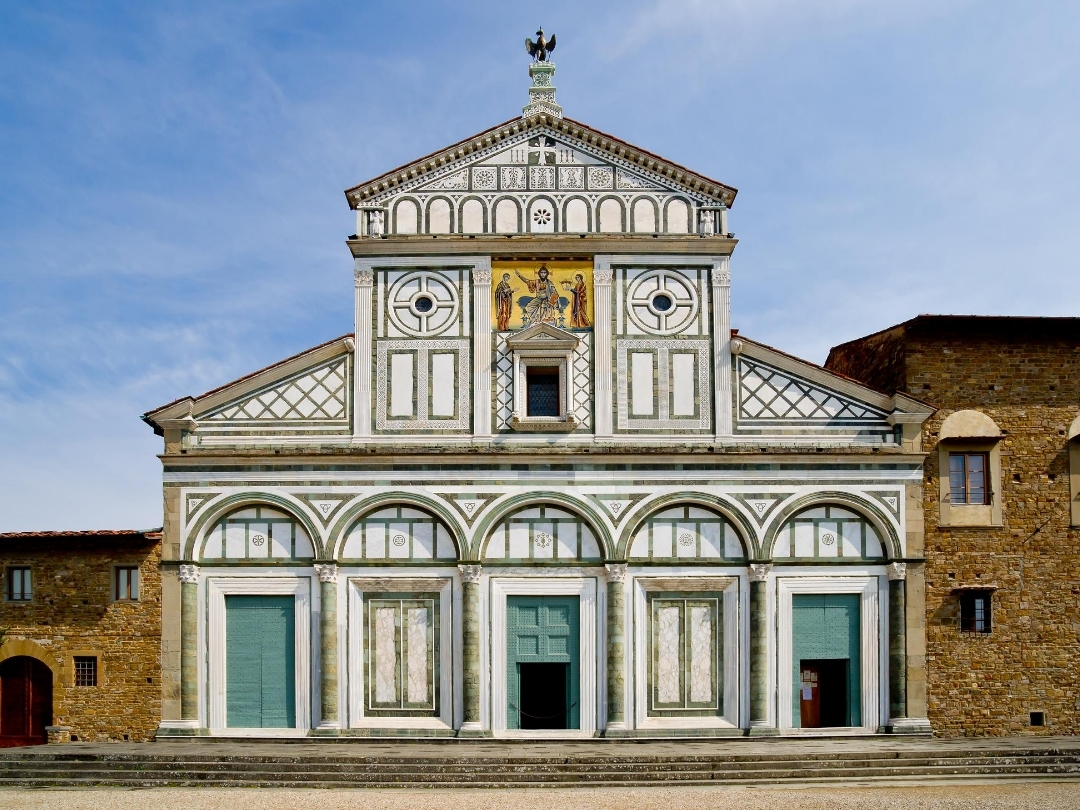 The Abbazia di San Miniato al Monte, or the Abbey of San Miniato al Monte, is a beautiful church and monastery on a hill overlooking Florence, Italy.
The Abbazia di San Miniato al Monte, or the Abbey of San Miniato al Monte, is a beautiful church and monastery on a hill overlooking Florence, Italy.
It is considered one of the city’s finest examples of Romanesque architecture. It is a popular destination for visitors seeking a glimpse into the history and artistry of Florence.
The abbey was founded in the early 11th century and was named after the martyr Saint Minias.
It features a stunning facade adorned with intricate carvings and colorful mosaics.
The church’s interior is equally impressive, with soaring vaulted ceilings, intricate frescoes, and stunning marble floors.
One of the highlights of the Abbazia di San Miniato al Monte is its beautiful crypt, located beneath the church.
The crypt features a stunning collection of frescoes that date back to the 13th century, as well as a number of ancient tombs and relics.
Another notable feature of the Abbazia di San Miniato al Monte is its stunning location.
The church is situated on a hill overlooking the city of Florence and provides panoramic views of the surrounding countryside.
Visitors can climb the church’s bell tower stairs for an even more breathtaking view of the city and its landmarks.
Mercato Centrale
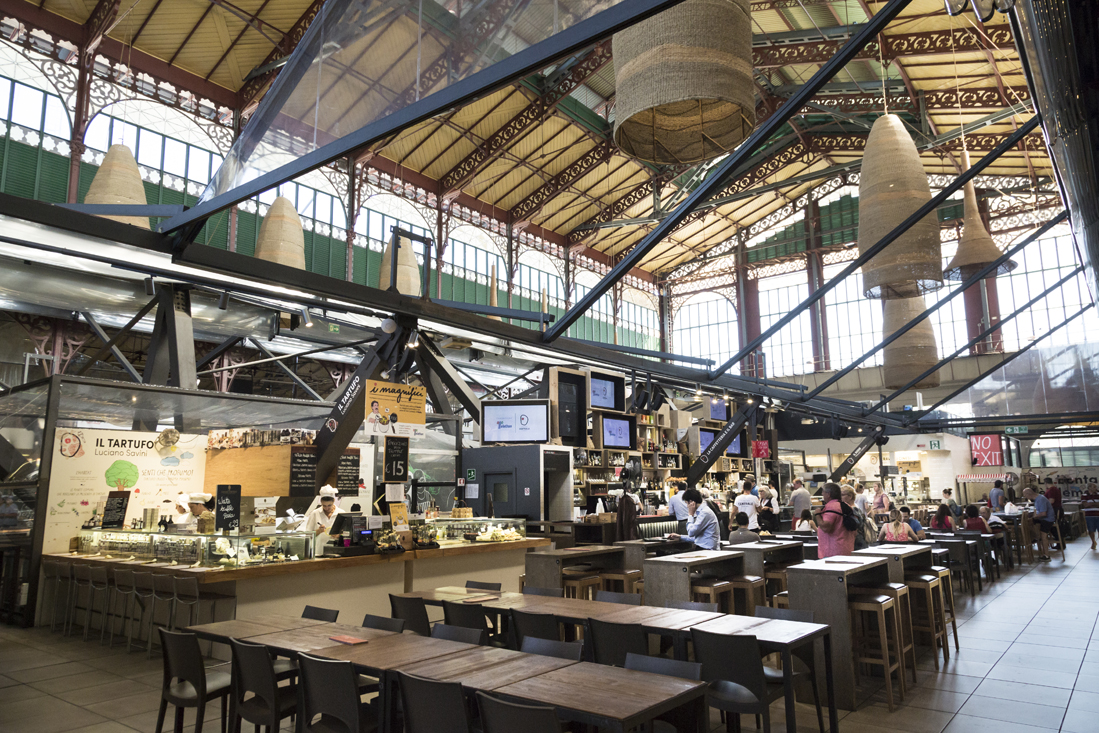 The Florence Central Market, also known as the Mercato Centrale, is a lively and bustling marketplace.
The Florence Central Market, also known as the Mercato Centrale, is a lively and bustling marketplace.
The market is a popular destination for locals and tourists and is considered one of the best places in the city to sample local food and wine.
The market is housed in a beautiful building that was constructed in the late 19th century and features a stunning iron and glass structure that is reminiscent of the historic markets of Paris.
The market is divided into two levels, with the ground floor featuring various stalls selling fresh produce, meats, fish, and cheeses.
In contrast, the upper level is home to a number of restaurants, cafes, and food vendors.
One of the highlights of the Florence Central Market is the variety of food on offer.
Visitors can sample a range of local specialties, including cured meats like prosciutto and salami, fresh cheeses like pecorino and ricotta, and a variety of fresh fruits and vegetables.
There are also a number of vendors selling freshly baked bread, pastries, and desserts, as well as a wide selection of wines and other local beverages.
Florence, Italy, is a city full of rich history, art, and culture, and there is no shortage of things to see and do.
Some of the best things to do in Florence in 2023 include exploring the city’s historic landmarks, such as the Duomo, the Palazzo Vecchio, and the Piazza della Signoria, and visiting some of its world-renowned museums and galleries, such as the Uffizi Gallery and the Accademia Gallery.
Visitors can also experience Florence’s culinary delights at its many restaurants and cafes, sample gelato at local gelaterias such as Gelateria dei Neri, and visit the bustling Central Market for a taste of local produce and cuisine.
The city’s beautiful parks and gardens, such as the Boboli Gardens and Piazza Michelangelo, provide a peaceful escape from the bustling streets.
The city’s vibrant nightlife scene offers plenty of opportunities for entertainment and socializing.
Overall, Florence is a city that truly has something for everyone, and visitors in 2023 can look forward to a memorable and enriching experience.
Be sure to check out our vlog The Go To Family. Connect with us on Instagram, Twitter, and Pinterest !


